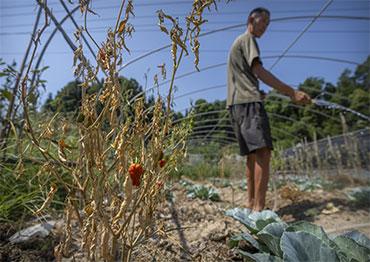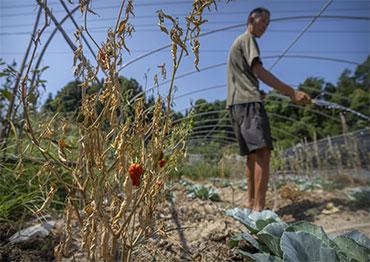The top issue during the devastating drought has been China’s food security. Given its enormous population, China has long adopted a policy of self-reliance. According to the 2019 white paper on food security issued by China’s State Council, China is self-sufficient for 95 percent of its rice, wheat and corn needs,which allowed the country to largely remain unscathed as the Russia- Ukraine war pushed up food prices around the globe.
But if droughts become more frequent along its major rivers, China’s ability to feed its population will be challenged. Rice and wheat are the two staple foods for Chinese dining tables. Rice is mainly grown in southern China, including the Yangtze basin, as well as the northeast of the country. Several major rice-growing areas along the Yangtze River, including Sichuan, Chongqing, Hubei, Hunan, Jiangxi and Anhui, suffered severe drought this summer.
On August 23, four government departments issued an urgent joint emergency notice, warning that the autumn harvest was under “severe threat,” urging local authorities to employ every tool at their disposal to safeguard it, including staggered irrigation, diversion of new water sources and cloud seeding. Central authorities ordered dozens of large reservoirs to release water downstream to ensure the availability of irrigation water.
The autumn harvest accounts for 75 percent of China’s grain output, and is essential for China to meet its annual target of harvesting 650 billion tons of grain. A month before the autumn harvest, the extent of the drought’s damage to crops remained unclear. In Duchang, Jiangxi Province, a county on the banks of Poyang Lake, China’s largest freshwater lake, the drought has caused crop failure on more than 30,000 mu (2,000 hectares), which accounts for about 10 percent of all farmland in the county.
Wang Jingchen, an agricultural official from Hunan Province in Central China, told NewsChina that the hardest hit agricultural areas are those that completely depend on natural precipitation, especially in hilly terrain. So far, only 54 percent of China’s total farmland has access to irrigation.
In Duchang, local authorities told NewsChina they have enough water reserves to provide irrigation to 70-80 percent of the farmland until early September. “If the rain doesn’t come by then, there’s nothing else we can do,” said agriculture official Zhou Xiaohua.
Despite the seemingly dire situation, China’s overall food security is under control, as the proportion of farmland hit by the drought is still relatively small and can be offset by increased crop yields because of rich rainfall elsewhere in China, said Lin Guofa, a senior analyst at consultancy firm Bric Agriculture Group.
Parts of dry northern China, which expect rain in the summer, saw levels far exceeding the average. The three provinces in northeastern China, Liaoning, Jilin and Heilongjiang saw rainfall of around 40 percent above average, leading to a projection of a better-than-usual autumn harvest. In 2021, grain harvest in the three provinces accounted for 26.8 percent of the national total.
But for many experts, the drought should alert for authorities to become more prepared as droughts will become more frequent.
Li Guoxiang, a research fellow with the Rural Development Institute with the Chinese Academy of Social Sciences, told NewsChina that a major problem revealed by the Yangtze drought is that since the region usually has abundant surface water, there is a lack of infrastructure such as motor-pumped wells to provide alternative water sources. The drought should be a wake-up call to ensure local authorities have contingency plans, Li said.
According to Lü Juan, China should establish a robust early warning and response system for drought. In April, the Ministry of Water Resources released a notice on working procedures for an emergency response system against floods and droughts, which Lü said outlined separate and specific criteria for an emergency response to droughts for the first time.
Lü said the Ministry of Water Resources has established a national drought monitoring and early warning platform, which is expected to be launched in March 2023.
A national response plan is under consideration, Lü told NewsChina. Such a plan is centered on setting up a “drought limit” line for major reservoirs. When water levels drop under the drought limit lines, a response plan would be triggered. But the system needs to take into consideration a variety of factors and involves water distribution and rationing among different stakeholders for industrial, agricultural, ecological and residential uses. It will be a complex process that takes a long time to take shape, Lü said.

 Old Version
Old Version




